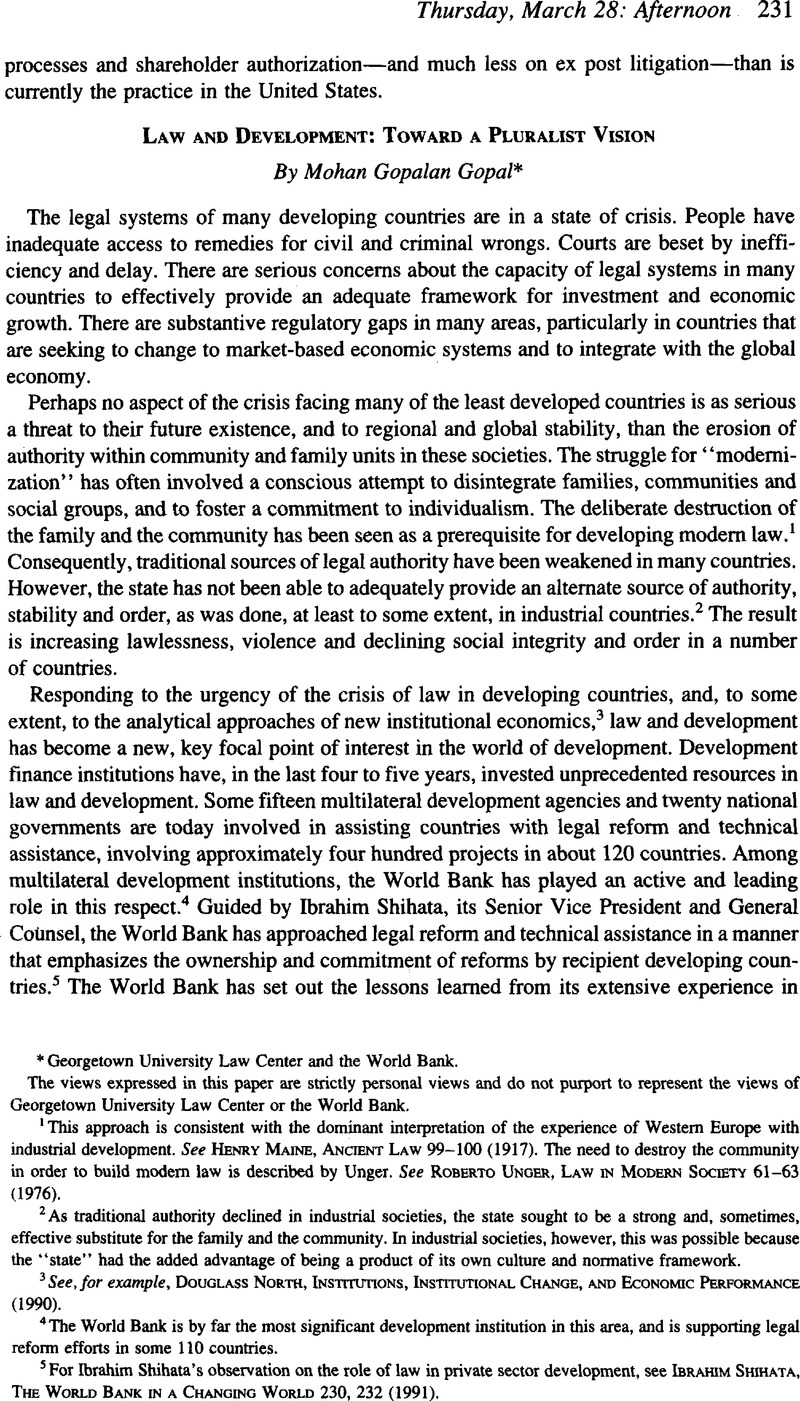Published online by Cambridge University Press: 17 February 2017

The views expressed in this paper are strictly personal views and do not purport to represent the views of Georgetown University Law Center or the World Bank.
1 This approach is consistent with the dominant interpretation of the experience of Western Europe with industrial development. See HENRY MAINE, ANCIENT LAW 99–100 (1917). The need to destroy the community in order to build modern law is described by Unger. See ROBERTO UNOER, LAW IN MODERN SOCIETY 61–63 (1976).
2 As traditional authority declined in industrial societies, the state sought to be a strong and, sometimes, effective substitute for the family and the community. In industrial societies, however, this was possible because the “state” had the added advantage of being a product of its own culture and normative framework.
3 See, for example, DOUGLASS NORTH, INSTITUTIONS, INSTITUTIONAL CHANGE, AND ECONOMIC PERFORMANCE (1990).
4 The World Bank is by far the most significant development institution in this area, and is supporting legal reform efforts in some 110 countries.
5 For Ibrahim Shihata's observation on the role of law in private sector development, see IBRAHIM SHIHATA, THE WORLD BANK IN A CHANGING WORLD 230, 232 (1991).
6 World Bank, The World Bank and Legal Technical Assistance: Initial Lessons (1995); World Bank, Resource Handbook: Multilateral and Bilateral Agencies Involved in Financing and Supporting Legal Technical Assistance (1996).
7 The countries in Africa, Asia and Latin America, where the crisis is at its worst, have been the main arenas of the law and development movement. There is little evidence here that the movement has produced any valuable insights for resolving the crisis. On the contrary, for reasons referred to in this paper, it appears that the intervention of the movement may have contributed to the crisis.
8 The body of scholarship on the topic of law and development, as well as the assistance provided to countries for legal reform in the past through sources other than multilateral institutions, is referred to loosely here as "the law and development movement." Multilateral institutions are excluded from the definition because they have only entered into the field in a systematic way relatively recently and also because of the differences in the approach that they appear to be taking.
9 David Trubek, Toward a Social Theory of Law: An Essay on the Study of Law and Development, 82 YALE L. J. 1 (1972) at 16.
10 David Trubek, Back to the Future: The Short Happy Life of the Law and Society Movement, 18 FLA. ST. U. L. REV. 4 (1990) at 20-21.
11 For an argument in favor of "creative social engineering," see, Michael Cernea, The Sociologist's Approach to Sustainable Development, FIN. & DEV., December 1993, at 11-13.
12 Human Rights in Domestic Law and Development Assistance Policies of the Nordic Countries 7-24 (L. A. Rehof and C. Gulman, eds., 4th ed., 1987).
13 See, for example, Art. I, Ch. II, the UN Charter of Economic Rights and Duties of States; and Part I, Art. 1, the International Covenant on Economic, Social and Cultural Rights.
14 David Trubek, Back to the Future: The Short, Happy Life of the Law and Society Movement, 18 FLA. ST. U. L. REV 4 (1990) at 37.
15 Louis Baeck, Shifts in Concepts and Goals of Development, GOALS OF DEVELOPMENT (UNESCO).
16 MAX WEBER, ECONOMY AND SOCIETY 891–892 (Guenther Ross & Claus Wittich, eds., 1978); see also, David Trubek, Toward a Social Theory of Law: An Essay on the Study of Law and Development, 82 YALE L.J. 1 (1972) at 11–13.
17 A. V. Dicey, Lectures on the Relation between Law and Public Opinion in England During the Nineteenth Century, quoted in SOCIOLOGY OF LAW 71–72 (Vilhelm Aubert, ed., 1977).
18 See, David Trubek, Back to the Future: The Short, Happy Life of the Law and Society Movement, 18 FLA. ST. U. L. REV. 4 (1990) at 20–21.
19 MAX WEBER, ECONOMY AND SOCIETY 811 (Guenther Ross & Claus Wittich, eds., 1978).
20 MORTON J. HORWITZ, THE TRANSFORMATION OF AMERICAN LAW, 1870–1960, 270 (1992).
21 IBRAHIM SHIHATA, THE WORLD BANK IN A CHANGING WORLD 227 (1991) (emphasis added).
22 MAX WEBER, ECONOMY AND SOCIETY 882–883 (Guenther Ross & Claus Wittich, eds., 1978).
23 A.V. Dicey, Lectures on the Relation between Law and Public Opinion in England During the Nineteenth Century, quoted in SOCIOLOGY OF LAW 71–72 (Vilhelm Aubert, ed., 1977).
24 For example, the government of a country asked for a review of the law governing recovery of debts owed to financial institutions in order to improve debt recovery by them. Previous reviews had used conventional approaches and recommended legislative changes that would bring local laws in line with benchmark industrial country laws. Several rounds of such legal reform had little impact on the problem of debt recovery. The latest review, however, adopted an empirical approach that analyzed the real local factors that led to payment and willful default. This empirical research indicated that a main reason why willful defaulters did not repay loans was that their access to future credit was not affected. The empirical analysis also revealed that a small number of lenders accounted for a large proportion of the debt. This information led to a strategy that, overall, has been more effective and responsive to the problem than the strategy of legislative change, or institutional strengthening, that came out of the traditional approach.